Uravu Labs, a climate tech company founded in 2017 in India, aims to provide 100% renewable water infrastructure for the 21st century. They have developed a patent-pending, solar-powered device that can source safe drinking water from the air. The company has conducted field pilots for its water technology and aims to rapidly test and scale the solution with key customers.
We may earn commission from links on this page, but we only recommend products we back.
Challenges: drinking water
According to the World Health Organization, 1.2 billion people do not have access to safe and high quality drinking water, and this number is increasing steadily; by 2025, an estimated one-third of the earth’s population could be without access to safe water.
People residing in areas with inadequate or inaccessible water sources may use equipment for obtaining potable water from dehumidification of atmospheric air. There have been systems to convert atmospheric moisture into potable freshwater for decades. However, widespread adoption of such systems has not yet occurred due to their high cost, operational inefficiencies, noise, cleanliness concerns, and a general lack of user engagement.
Source developed novel solar thermal and desiccant-based systems for generating water from atmospheric air. In the system, the solar heat element and the desiccant unit are physically integrated and are in direct fluidic communication. This configuration restricts daily water production to between 5 and 20 liters per system. If the application requires greater water production than 20 liters per day, then it would be necessary to install a large number of these systems, and each single system costs $4,000-$6,000. Each liter of water produced costs $0.15.
In addition, only during solar hours do Source‘s desiccant-based atmospheric water generator systems produce water. This is because heat is required as an essential step in the water vapor desorption mode, and in solar heat-operated systems, heat is only available during solar hours. This reduces the capacity utilization factor of the atmospheric water generator systems’ components.
Therefore, there is a need for an improved atmospheric water generator system that produces potable water more efficiently and engages the user in a manner that ensures their continued use of the machine.
This book provides technical and scientific aspects of water-from-air machine for prospective buyers, owners, and users. (see on Amazon)
Uravu Labs Technology
Uravu Labs develops scalable solar thermal and desiccant-based atmospheric water generator systems for the continuous generation of water from atmospheric air.
In Uravu Labs’ systems, the solar heat unit and the desiccant unit are only in fluidic communication with one another and are not physically integrated. Therefore, the solar heat unit and the desiccant unit can be independently and linearly scaled up to build low-cost systems with capacities well beyond 20 liters per day.
In addition, the systems contain a thermal storage unit that supplies the desiccant unit with the necessary heat for its water vapor desorption mode. Consequently, the desiccant material in the desiccant unit may be active during non-solar hours, increasing the capacity utilization factor of the water generator systems to near 100%.
The water generator system
The Uravu Labs’s typical water generator system is schematically depicted in the diagram below.

The system consists of the following components:
- The solar heat unit to heats up the heat transfer fluid;
- The thermal storage unit that consists of a hot storage unit and a cold storage unit for storing heat;
- Two desiccant units, consisting of desiccant material, a desiccant heating element, and a desiccant holder, for absorbing and desorbing water vapor during absorption and desorption model, respectively;
- Air-filtering units for supplying desiccant units with dust-free air;
- The condenser unit to condense water vapor in order to produce liquid water;
- A water filtration unit to remove particle impurities;
- A mineralizing unit coupled to the condenser unit for adding essential minerals to the condensed water in order to produce potable water;
- Valves to regulate fluid exchange between the desiccant unit and atmospheric air and between the desiccant unit and the condenser unit;
- Pumps to establish fluid communication between the solar heat unit and the thermal storage unit, as well as between the desiccant unit and the thermal storage unit; and
- Solar cells and battery storage to provide power on spot.
How does the system work?
During the day, the solar heat unit heats up the heat transfer fluid and delivers it to the thermal storage unit in order to facilitate the storage of heat.
As illustrated in the figure below, while the first desiccant unit is in the adsorption mode, the second desiccant unit is in the desorption mode.
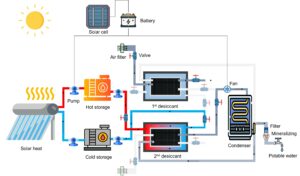
Over the desiccant material in the first desiccant unit, atmospheric air humidity is absorbed. Once the desiccant material has been saturated with the water vapor content during the adsorption mode, the fluidic communication between the first desiccant unit and the atmospheric air is discontinued, and this marks the start of the desorption mode.
While the first desiccant unit is in its adsorption mode, the second desiccant unit is in its desorption mode. The second desiccant unit and the condenser unit are in fluidic communication. The hot heat transfer fluid is delivered to the desiccant heating element of the second desiccant unit, where it is cooled, before being transferred to the cold storage unit to be later heated by the solar heat unit.
During the desorption mode in the second desiccant unit, water vapor and trapped air are released and condensed in the condenser unit. The return air is recirculated to the second desorption unit, where it mixes with the newly formed water vapor and is then fed back to the condenser unit to complete a closed loop.
Once the desiccant material in the second desiccant unit has desorbed most of the humidity, the fluidic communication among the second desiccant unit, the condenser unit, and the hot heat transfer fluid is discontinued. This marks the start of the adsorption mode in the second desiccant unit and the desorption mode in the first desiccant unit, as illustrated in the diagram below.
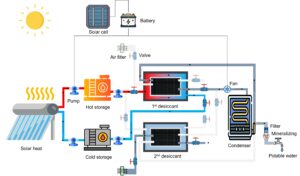
Although the system has two desiccant units, only one condenser unit is used to condense water vapor to produce potable water. Depending on which desiccant unit is in the desorption mode, that desiccant unit is in fluidic communication with the thermal storage unit and the condenser unit. The system ensures that the capacity utilization factor of the condenser unit is near 100% while producing water from the atmospheric air throughout the day and the night.
Uravu Labs Products
Uravu Labs’s water generator systems are easily scalable and inexpensive. The systems can extract 20 to 100 liters of water per day from thin air. Their renewable water is priced similarly to mineral water, at approximately $0.078 per liter. As they scale up, the cost of water can decrease. At 100-200 liters daily extraction, the costs will be around $0.052. At 2,000 to 10,000 liters and beyond, the price per liter will drop to $0.026 to $0.032.
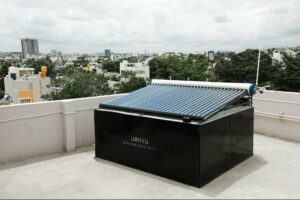
Uravu Labs now targets Indian beverage brands. Uravu Labs is assisting beverage companies such as AB InBev, Moonshine Meadery, Coca-Cola, Radico Khaitan, Kirin Holdings, and Suntory to extract water from air and reduce their carbon footprint to zero using their pilot technology.
Uravu Labs Funding
Uravu Labs has raised a total of $2M in funding over 2 rounds. Their latest funding was raised on Aug 9, 2022 from a Seed round.
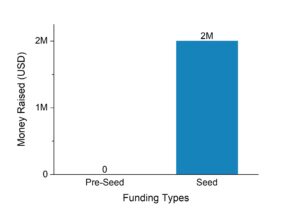
Uravu Labs Investors
Uravu Labs is funded by 7 investors, including Speciale Invest, Rocketship.vc, Spectrum Impact, VERSO Capital, Venture Catalysts, Echo River Capital, and Anicut Capital. Speciale Invest and Rocketship.vc are the most recent investors.
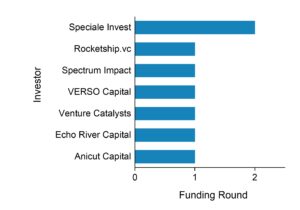
Uravu Labs Founders
Pardeep Garg, Swapnil Shrivastav, Venkatesh RY, and BALAJI GB are Co-founders.
Uravu Labs CEO
Swapnil Shrivastav is CEO.
